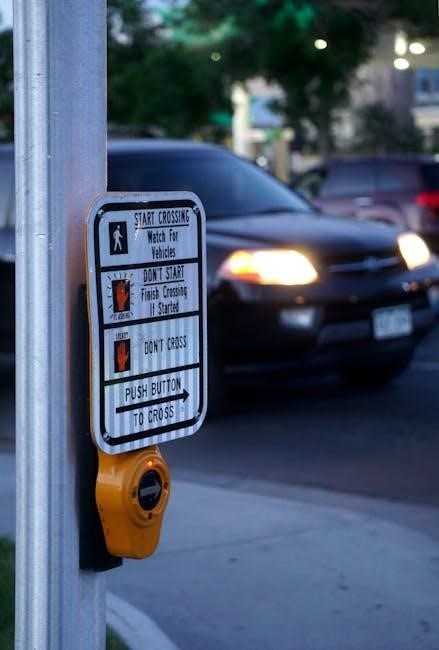
This manual provides a comprehensive guide for using Digital Signature Certificates (DSC) in patent applications. It covers e-filing processes‚ system requirements‚ and troubleshooting for seamless DSC integration.
1.1. What is a Digital Signature Certificate (DSC)?
A Digital Signature Certificate (DSC) is an electronic equivalent of a physical certificate‚ used to authenticate the identity of individuals or organizations. It ensures security and authenticity in digital transactions. DSCs are issued by certified authorities and contain details like name‚ email‚ and public/private keys. In the context of patent applications‚ a Class 3 DSC is mandatory for e-filing in India‚ enabling secure submission and verification of documents. It plays a crucial role in maintaining integrity and compliance in intellectual property filings.
1.2. Importance of DSC in Patent Applications
A Digital Signature Certificate (DSC) is essential for securing and authenticating electronic patent applications. It replaces traditional wet signatures‚ ensuring compliance with legal requirements. DSCs verify the identity of the applicant‚ maintaining the integrity of the filing process. They are mandatory for agents‚ organizations‚ and individuals submitting patent applications online in India. By eliminating the need for physical documents‚ DSCs streamline the e-filing process‚ reducing delays and enhancing efficiency. This digital authentication also safeguards against tampering‚ ensuring the security of sensitive information in intellectual property filings.
1.3. Overview of the E-Filing Process for Patents
The e-filing process for patents involves submitting applications electronically through the official patent portal. Applicants must prepare required documents‚ fill out forms‚ and upload them online. The process includes creating a user account‚ submitting provisional or complete specifications‚ and paying fees. Digital Signature Certificates (DSC) are mandatory for signing and authenticating documents. After submission‚ applicants receive an acknowledgment receipt. This method reduces delays‚ ensures transparency‚ and aligns with environmental goals by minimizing paper use. The e-filing system also provides a secure and efficient way to track application status‚ making it a preferred method for patent filing.

Step-by-Step Guide to Obtaining a DSC
Obtain DSC by selecting a certifying authority‚ verifying eligibility‚ submitting documents‚ and completing the application process. Receive and activate the token for secure patent e-filing.
2.1. Eligibility Criteria for DSC
To obtain a DSC for patent applications‚ applicants must meet specific eligibility criteria. Individuals and businesses are eligible‚ provided they furnish valid identity and address proofs. The DSC is issued to authenticate the identity of the signer and ensure the integrity of electronic submissions. Applicants must comply with the certifying authority’s guidelines‚ ensuring all documents are genuine and up-to-date. The certifying authority verifies the applicant’s details to maintain security and compliance with legal standards.
2.2. Types of DSC for Patent Applications
For patent applications‚ two primary types of Digital Signature Certificates (DSCs) are used: Class 2 and Class 3. A Class 2 DSC is suitable for individuals and is commonly used for signing patent documents. Class 3 DSCs are more secure and typically used by organizations or authorities. Both types ensure authenticity and integrity of electronic submissions. Class 3 DSCs offer advanced security features‚ making them ideal for high-stakes processes like patent filings. The choice depends on the applicant’s requirements‚ ensuring compliance with legal and technical standards for e-filing patent applications in India.
2.3. Documents Required for DSC Application
To apply for a Digital Signature Certificate (DSC)‚ specific documents are mandatory. For individuals‚ these include a valid photo ID (e.g.‚ Aadhaar‚ PAN‚ or passport)‚ address proof (e.g.‚ Aadhaar‚ utility bills)‚ and a passport-sized photograph. For organizations‚ documents like a registration certificate‚ incorporation certificate‚ and authorized signatory proof are required. Additional documents such as a PAN card or GST certificate may be needed for business entities. Ensure all documents are recent‚ valid‚ and attested as per the certifying authority’s guidelines. These documents verify identity and eligibility for issuing the DSC.
2.4. Application Process for DSC
The DSC application process involves submitting the required documents to a Certified Authority. Visit the official website of a licensed Certifying Authority (CA) and fill out the application form. Upload scanned copies of your identity‚ address‚ and other supporting documents. Pay the prescribed fee online. Post-verification‚ the CA will conduct a video KYC or in-person verification. Once approved‚ the DSC is issued and sent via email or USB token. Ensure all details are accurate to avoid delays. The process typically takes 1-3 working days for approval and issuance of the DSC.
2.5. Verification and Approval Process
After submitting the DSC application‚ the Certifying Authority (CA) verifies the documents and applicant details. A video KYC or in-person verification is conducted to authenticate the applicant’s identity. The CA checks the accuracy of submitted documents and ensures compliance with legal standards. Once verified‚ the application is approved‚ and the DSC is generated. The approval process typically takes 1-3 working days. Upon approval‚ the DSC is issued via email or USB token. Ensure all details are accurate to avoid rejection. The CA may request additional documents if discrepancies are found during verification.

Installation and Registration of DSC
Install the DSC token driver‚ follow on-screen instructions‚ and register Capicom.dll. Ensure compatibility with your Windows system for smooth functionality during patent e-filing processes.
3.1. System Requirements for DSC Installation

Ensure your system meets the necessary requirements for DSC installation. A Windows operating system (64-bit preferred) with a dual-core or quad-core processor is recommended. At least 4GB RAM (8GB or more recommended) is essential for smooth performance. The .NET Framework version 4.6.2 or higher must be installed. Internet Explorer 11 or the latest Microsoft Edge version should be available. Ensure your firewall settings allow DSC applications and that administrator rights are enabled for installation. A malware-free system is also crucial for uninterrupted functionality.
3.2. Step-by-Step Installation Guide
Download the DSC installer from the official Certificate Authority website. Run the setup file and follow the on-screen instructions. Select the installation location and choose the correct options for your system. Accept the terms and conditions‚ then proceed to install. Once installed‚ restart your computer to ensure proper configuration. Insert your DSC token into the USB port and ensure it is recognized by the system. Open the application and complete the registration process if prompted. Verify the installation by signing a test document to ensure functionality. Ensure all drivers and software are up-to-date for optimal performance.
3.3. Registration of Capicom.dll for Windows
To register Capicom.dll‚ open the Command Prompt as Administrator. Type the command: regsvr32 capicom.dll and press Enter. If the file isn’t in the System32 folder‚ specify the full path. A confirmation message will appear upon successful registration. Restart your system to apply changes. For 64-bit systems‚ ensure the correct version of Capicom.dll is used. If issues arise‚ re-register the DLL or check for system compatibility. Proper registration is essential for DSC functionality in patent applications.

3.4. Troubleshooting Common Installation Issues

Common issues during DSC installation include error messages during Capicom.dll registration or driver incompatibility. If Capicom.dll fails to register‚ ensure you’re using the correct version for your Windows architecture (32-bit or 64-bit). Run Command Prompt as Administrator and retry the registration command. For driver issues‚ update or reinstall DSC token drivers from the manufacturer’s website. If the token isn’t detected‚ check USB port functionality or try a different port. Ensure your system meets the minimum requirements for DSC installation. If problems persist‚ contact your DSC provider’s support team for assistance.

E-Filing Process for Patent Applications
The e-filing process involves accessing the patent portal‚ creating a user account‚ uploading documents‚ and using DSC for digital signatures. Submit the application and make payments online.
4.1. Accessing the Official Patent E-Filing Portal
To access the official patent e-filing portal‚ visit the government’s designated website. Ensure your browser is compatible and supports necessary plugins. Navigate to the “E-Filing” section‚ select the appropriate patent type‚ and log in using your registered credentials. For first-time users‚ complete the registration process by providing required details. Ensure Java and JavaScript are enabled in your browser for smooth functionality. The portal is optimized for desktop and laptop use‚ with limited mobile compatibility. Always use an updated browser version to avoid technical issues during the process. For assistance‚ refer to the portal’s help section or contact support. Access the portal here.
4.2. Creating a User Account for E-Filing
To create a user account for e-filing patent applications‚ navigate to the official portal and select the “Register” or “Create Account” option. Fill in the required details‚ including your name‚ email address‚ phone number‚ and organization information. Ensure all fields marked with an asterisk (*) are completed accurately. Choose a strong password and confirm it; Click “Submit” to proceed. A verification link or OTP will be sent to your registered email or phone. Verify your account by clicking the link or entering the OTP. Once verified‚ log in with your credentials to access the e-filing dashboard. Register here for a seamless experience.
4.3. Uploading Required Documents for Patent Application
After logging in‚ navigate to the “Upload Documents” section on the e-filing portal. Select the appropriate document type from the dropdown menu‚ such as “Patent Application” or “Provisional Specification.” Click “Choose File” to upload your documents in PDF‚ DOC‚ or DOCX format. Ensure files comply with size limits and formatting guidelines. Enter the title and description for each document. Use the “Add More” button to upload multiple files. Once all documents are uploaded‚ review them for accuracy. Click “Save and Continue” to proceed to the next step in the e-filing process. Ensure all required documents are uploaded before final submission.
4.4. Using DSC for Signing Documents
Once documents are uploaded‚ proceed to the “Sign Documents” section. Select the document requiring a digital signature. Choose your DSC from the dropdown menu or browse to locate the certificate. Enter the DSC token PIN when prompted. Click “Sign” to apply the digital signature. A confirmation message will appear upon successful signing. Repeat for additional documents if required. Ensure the signature is applied to all mandatory fields. Verify the signed documents before submission. The DSC ensures authenticity and compliance with patent office requirements‚ making the application legally valid and secure.
4.5. Submitting the Application and Payment
After signing all documents‚ review the application for accuracy. Click “Submit” to proceed to the payment page. Select a payment method (e.g.‚ credit/debit card‚ net banking‚ or UPI). Enter payment details and complete the transaction. A receipt will be generated upon successful payment. Download and save the receipt for future reference. The system will send a confirmation email with the application number. Note the application number for tracking. Ensure all steps are completed within the portal’s time limits to avoid session expiration; Once submitted‚ no changes can be made‚ so verify all details before finalizing.

Technical Requirements for DSC Usage
Ensure your system has compatible software‚ supported browsers‚ and Java installed. Verify DSC token drivers are updated and compatible with your operating system for seamless functionality.
5.1. Browser Compatibility for DSC
Ensure your browser is compatible with DSC‚ such as Chrome‚ Firefox‚ or Edge. Enable JavaScript and pop-ups‚ as these are essential for DSC functionality. Avoid using outdated browsers‚ as they may not support digital signatures. Verify that your browser is configured to recognize and integrate with the DSC token. Additionally‚ ensure Java is installed and up-to-date‚ as it is required for DSC operations. Test your browser settings before e-filing to avoid technical issues. Using an incompatible browser may result in signing errors or failed submissions.
5.2. Configuring Microsoft Edge for DSC
To configure Microsoft Edge for DSC‚ install the Digital Signature extension from the Chrome Web Store‚ as Edge supports Chrome extensions. Enable JavaScript and pop-ups in settings. Clear cache and cookies regularly to avoid conflicts. Ensure the DSC token is recognized by the browser. For troubleshooting‚ disable extensions that may interfere with DSC functionality. Restart Edge after making changes. Verify compatibility by testing the DSC token on a sample document before proceeding with patent e-filing. Proper configuration ensures seamless digital signature integration and prevents errors during submission.
5.3. Ensuring Proper Internet Explorer Mode Settings
For seamless DSC functionality‚ enable Internet Explorer (IE) mode in Microsoft Edge. Access Edge settings‚ navigate to Default browser‚ and toggle on Allow the use of IE mode for all InPrivate and guest sessions. Add the official patent portal to the Site list under Internet Explorer integration. Ensure JavaScript and ActiveX are enabled for IE mode sites. Clear browsing data and restart Edge after configuring. Verify that the DSC token is recognized in IE mode by signing a test document. Proper IE mode settings prevent signing errors and ensure compatibility with legacy systems used in patent e-filing.
5.4. Managing Browser Extensions and Plug-ins
Ensure browser extensions and plug-ins are configured to support DSC functionality. Disable or remove unnecessary extensions that may interfere with the DSC token; Enable only trusted extensions like Adobe Acrobat or Java‚ which are essential for document signing. Regularly update extensions to maintain compatibility with the latest browser versions. Clear cache and cookies to prevent conflicts. Restart the browser after making changes to apply updates. Proper management of extensions ensures smooth DSC operation and prevents errors during patent e-filing.

Common Issues and Solutions
Common issues with DSC include signing errors‚ browser incompatibility‚ and token detection problems. Solutions involve updating software‚ checking browser settings‚ and ensuring stable internet connectivity.
6.1. Troubleshooting DSC Signing Errors
Troubleshooting DSC signing errors involves identifying the root cause‚ such as invalid signatures‚ certificate mismatches‚ or token issues. Ensure the DSC is correctly registered and the PIN is entered accurately. Verify that the certificate details match the application. Check system clock settings‚ as incorrect timestamps can invalidate signatures. Clear browser cache and restart the application. If issues persist‚ re-register the DSC or contact the Certificate Authority for further assistance. Regularly updating DSC drivers and software can prevent recurring errors. Always maintain the latest system updates for optimal functionality.
6.2. Resolving Capicom.dll Registration Issues
Capicom.dll registration issues can disrupt DSC functionality. To resolve this‚ open Command Prompt as Administrator and run the command: regsvr32 capicom.dll. Ensure the file is located in the correct system directory. If the issue persists‚ check if your system supports 32-bit applications‚ as Capicom.dll is 32-bit. Restart your system after registration. Verify that all dependencies are updated and compatible with your operating system. Reinstalling the DSC software may also resolve the issue. Always ensure your system is updated to avoid compatibility conflicts. If problems remain‚ consult your DSC provider for further assistance.
6.3. Fixing Browser Compatibility Problems
Browse incompatibility can hinder DSC functionality during patent e-filing. Ensure you use browsers like Internet Explorer‚ Mozilla Firefox‚ or Google Chrome in compatibility mode. Enable plug-ins and add-ons required for DSC. Clear cache and cookies to resolve conflicts. If using Microsoft Edge‚ switch to Internet Explorer mode. Verify that your browser supports Java and ActiveX controls. Update your browser to the latest version and ensure it aligns with DSC software requirements. If issues persist‚ reinstall browser extensions or reset browser settings to default. Always refer to the DSC provider’s guidelines for browser configuration. Troubleshooting browser settings can resolve most compatibility issues effectively.
6.4. Addressing Payment Gateway Time Restrictions
Payment gateway time restrictions can delay patent application submissions. Ensure stable internet connectivity to prevent timeouts. Verify DSC installation and registration to avoid recognition issues. Clear browser cache and cookies to eliminate glitches. Use compatible browsers and update them regularly. Check payment gateway requirements and configure settings accordingly. If issues persist‚ contact the payment gateway support for assistance. Consider reaching out to your DSC provider for specific integration recommendations. Proactive troubleshooting and seeking support can help overcome these restrictions efficiently‚ ensuring smooth transaction processing for patent applications.

Best Practices for DSC Usage
Always maintain your DSC token securely‚ keep software updated‚ use compatible browsers‚ and monitor for unauthorized access to ensure efficient and secure patent application processes.
7.1. Safeguarding Your DSC Token
Protect your DSC token with utmost care to prevent unauthorized access. Store it in a secure location‚ avoid sharing your PIN‚ and ensure physical safety. Never disclose your credentials to third parties. Use strong antivirus software to shield against malware. Avoid using public computers for DSC operations and ensure your device is password-protected. Regularly monitor for unauthorized access and report suspicious activities immediately. Keep your token and PIN separate and avoid labeling them. Use encrypted connections and secure networks when accessing sensitive systems. By prioritizing security‚ you maintain the integrity of your DSC and safeguard your patent application process.
7.2. Regularly Updating DSC Drivers and Software
Regularly updating your DSC drivers and software is crucial for maintaining compatibility and security. Check the official website of your DSC provider for the latest updates. Download and install updates promptly to ensure optimal performance. Enable auto-update features if available to streamline the process. After updating‚ restart your system to apply changes. Keep your software and drivers up-to-date to avoid technical issues during patent e-filing. This ensures smooth functionality‚ enhanced security‚ and compliance with the latest regulatory requirements. Regular updates also prevent potential errors and ensure seamless integration with the e-filing portal.
7.3. Maintaining Browser and System Updates
Maintaining updated browsers and systems is essential for seamless DSC functionality. Enable automatic updates for your operating system‚ browser‚ and plugins to ensure compatibility with DSC tools. Regular updates often include security patches and performance improvements‚ which are critical for secure patent e-filing. Outdated software may cause compatibility issues‚ leading to errors during document signing. Schedule regular system checks and restart your computer after updates to apply changes. This ensures your environment remains compatible with DSC requirements‚ preventing technical hiccups during critical filing processes. Consistent updates help maintain a smooth and secure experience for patent applications.
7.4. Avoiding Common Mistakes in E-Filing
To ensure a smooth patent e-filing process‚ avoid common mistakes such as missing deadlines‚ incomplete forms‚ or incorrect document uploads. Always verify the DSC token is properly registered and configured before signing. Double-check document formats and sizes to meet portal requirements. Ensure payment gateways are functioning and transactions are completed within time limits. Avoid last-minute submissions to account for unexpected delays. Regularly review and update user credentials to prevent login issues. By addressing these potential pitfalls‚ you can streamline the e-filing process and reduce the risk of application rejection or processing delays.
The DSC Patent Application Sign Manual guides users through obtaining‚ installing‚ and using Digital Signature Certificates for efficient and secure patent e-filing‚ ensuring compliance and streamlining processes.
8.1. Summary of Key Points
The DSC Patent Application Sign Manual provides a comprehensive guide for obtaining‚ installing‚ and utilizing Digital Signature Certificates in patent e-filing. It emphasizes the importance of DSCs in ensuring authenticity and security‚ outlines the step-by-step process for procurement and installation‚ and offers practical advice on troubleshooting common issues. The manual also covers technical requirements‚ such as browser compatibility and system updates‚ to ensure seamless functionality; By following best practices like safeguarding tokens and maintaining software updates‚ users can streamline the e-filing process. This guide is essential for anyone aiming to navigate patent applications efficiently and securely in the digital age.
8.2. Future of DSC in Patent Applications
The future of DSC in patent applications is promising‚ with advancements in technology enhancing security and efficiency. As digitalization progresses‚ DSCs will likely integrate with AI and blockchain for improved authenticity and automation. Governments may expand DSC adoption across more jurisdictions‚ streamlining global patent filings. Enhanced security measures‚ such as biometric authentication‚ could become standard. Additionally‚ user-friendly interfaces may simplify the process‚ reducing errors and increasing accessibility. These advancements will solidify DSCs as a critical tool in modern patent applications‚ ensuring secure and efficient e-filing processes for inventors and organizations worldwide.
8.3. Final Tips for Streamlining the Process
To streamline the DSC patent application process‚ ensure all documents are prepared in advance and double-checked for accuracy. Regularly update your system‚ browser‚ and DSC software to avoid compatibility issues. Maintain a backup of your DSC token and passwords in a secure location. Plan ahead to avoid last-minute delays‚ especially during payment processing. Stay informed about updates to patent filing rules and DSC requirements. Lastly‚ consider seeking professional assistance if you encounter persistent issues. By following these tips‚ you can ensure a smooth and efficient patent application process.